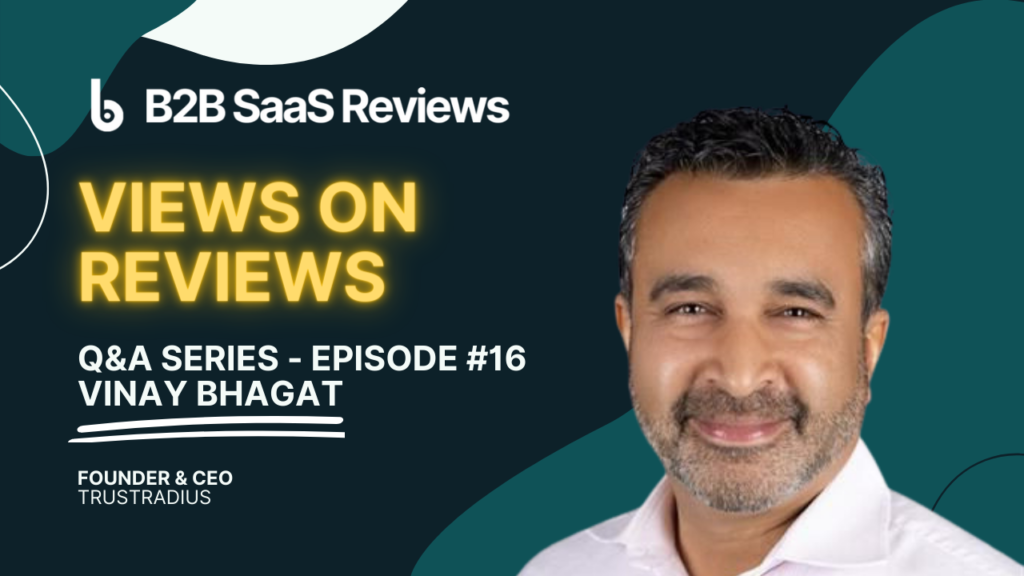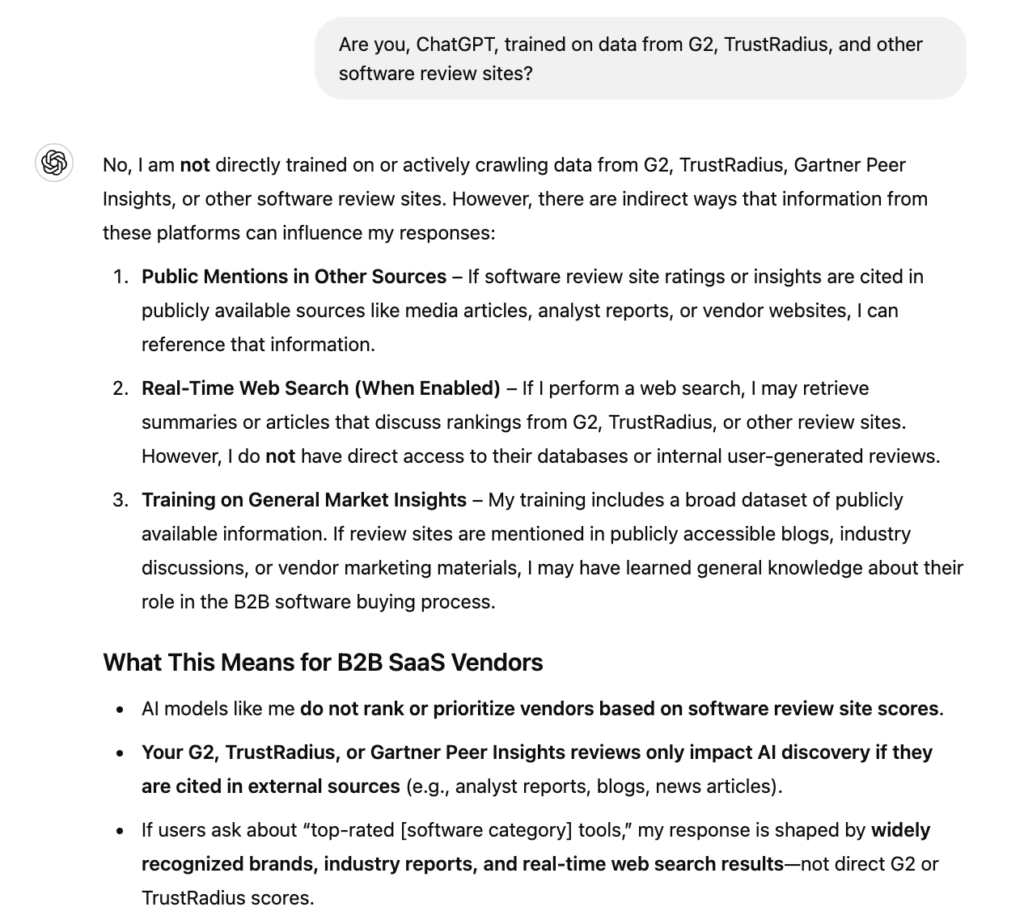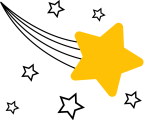After learning online reviews strategy in B2B SaaS, it’s time to get down to business and generate reviews. This post introduces the tactics for generating online reviews in B2B SaaS and examples of how other business software companies have done it.
It’s common knowledge that online reviews are important in today’s B2B software purchase decisions. This article offers a guide on how to generate online reviews effectively.
It covers important factors like identifying the team responsible for this task, deciding whether to request reviews from all users or just the satisfied ones and choosing between automated or manual asks. The article also provides over a dozen tactics and examples from various B2B SaaS companies, showing different ways to ask for reviews, such as by email campaigns, at events, and in-app at key moments like user milestones.
This guide is useful for those starting or seeking to improve their review generation strategy, offering valuable insights and actionable advice to enhance this process.
Note: this post was originally published in 2022 in a broader how-to guide for online reviews, which has been separated into a few pieces. This is the review generation tactics piece and has been updated for 2024.
Review Generation Tactics in B2B Software
Review Generation Tactics Roundup
An excellent place to start is to learn how to generate reviews with the review sites’ advice on review generation.
Here is a non-exhaustive roundup of the advice from some of the review sites:
- Top 12 Ways to Generate More Reviews by TrustRadius
- 14 ways to collect B2B software reviews by Gartner Digital Markets
- The 2021 G2’s Reviews Playbook, the Anatomy of Reviews, and Assess Your Review Collection Strategy by G2
Many tactics come up repeatedly across sources. Generally speaking, start with the most commonly recommended approaches.
Here is a list of the most commonly recommended review generation (request) approaches:
- Email campaigns – sent by the vendor
- Email campaigns – sent by the review site on behalf of the vendor
- In-person customer events – set up a review booth or ask for reviews at your booth
- Webinars and virtual events – ask your users to at the end of the event
- User groups or training sessions – find a good time to ask for reviews
- User communities or forums – create a discussion on reviews
- In your product/app – message in-app
Email is foundational to any review generation strategy, so it’s worth highlighting how you can leverage email for reviews:
- Email blasts – make an email list, and send an email or two to that list
- Customer Newsletters – weave review requests into it
- Email nurtures – add review requests to select nurture streams, such as an onboarding email nurture stream. The email within the nurture stream could be standalone (focused on the review request) or as a CTA in another email (focused on something other than the review request).
- Emails triggered by user milestones
- G2 recommends triggering email review requests to send after the user achieves milestones such as when they:
- Implement your software
- Renew or upgrade
- Surpass a usage threshold with your software
- Have been a customer for 90 days
- Have had their Quarterly Business Review
- Have submitted an NPS Survey
- G2 recommends triggering email review requests to send after the user achieves milestones such as when they:
The easiest way to generate reviews is by emailing users for a review.
In G2’s “Outreach Best Practices – Your Guide for Getting Reviews,” they go through the standard four-step process to email review outreach:
- Step 1: Prep your customer list
- Step 2: Craft your email(s)
- Step 3: Follow up with up to 2 reminders
- Step 4: Track campaign performance & thank reviewers
The secondary review generation tactics, i.e. the ones that seem to be recommended by one or two of the business software review sites, are:
- Employee email signatures – Customer-facing staff use an email signature with a review request as the call-to-action.
- Customer support communications – Support staff ask users to review after resolving their support tickets.
- Customer-facing team contests – Customer-facing teams ask the users they work with directly for reviews and get rewarded.
- Social media posts – Marketing posts ask their users to write them a review.
- Customer calls, emails, Slack messages, and other 1:1 communication channels – Customer-facing teams leverage the communication channel they see best fit to ask a user for a review.
- On your website – Marketing adds a review request call-to-action, such as on a Customers page.
- Customer Advisory Board (CAB) – Whoever runs the CAB asks the CAB members to provide a review.
- Supplement existing marketing campaigns with review requests – Customer Marketing weaves in review requests as secondary calls to action into their campaigns, such as in upselling and cross-selling focused campaigns.
After learning why user reviews matter in B2B SaaS and where buyers go for reviews comes the hard part: how do you generate reviews? This post introduces the strategy and tactics for generating online reviews in B2B SaaS.
It’s common knowledge that online reviews are important in today’s B2B software purchase decisions. This article offers a guide on how to generate online reviews effectively.
It covers important factors like identifying the team responsible for this task, deciding whether to request reviews from all users or just the satisfied ones and choosing between automated or manual asks. The article also provides over a dozen tactics and examples from various B2B SaaS companies, showing different ways to ask for reviews, such as by email campaigns, at events, and in-app at key moments like user milestones.
This guide is useful for those starting or seeking to improve their review generation strategy, offering valuable insights and actionable advice to enhance this process.
Note: this post was originally published in 2022 in a broader how-to guide for online reviews, which has been separated into a few pieces. This is the review generation tactics piece and has been updated for 2024.
Review Generation Tactics in B2B Software
Review Generation Tactics Roundup
An excellent place to start is to learn how to generate reviews with the review sites’ advice on review generation.
Here is a non-exhaustive roundup of the advice from some of the review sites:
- Top 12 Ways to Generate More Reviews by TrustRadius
- 14 ways to collect B2B software reviews by Gartner Digital Markets
- The 2021 G2’s Reviews Playbook, the Anatomy of Reviews, and Assess Your Review Collection Strategy by G2
Many tactics come up repeatedly across sources. Generally speaking, start with the most commonly recommended approaches.
Here is a list of the most commonly recommended review generation (request) approaches:
- Email campaigns – sent by the vendor
- Email campaigns – sent by the review site on behalf of the vendor
- In-person customer events – set up a review booth or ask for reviews at your booth
- Webinars and virtual events – ask your users to at the end of the event
- User groups or training sessions – find a good time to ask for reviews
- User communities or forums – create a discussion on reviews
- In your product/app – message in-app
Email is foundational to any review generation strategy, so it’s worth highlighting how you can leverage email for reviews:
- Email blasts – make an email list, and send an email or two to that list
- Customer Newsletters – weave review requests into it
- Email nurtures – add review requests to select nurture streams, such as an onboarding email nurture stream. The email within the nurture stream could be standalone (focused on the review request) or as a CTA in another email (focused on something other than the review request).
- Emails triggered by user milestones
- G2 recommends triggering email review requests to send after the user achieves milestones such as when they:
- Implement your software
- Renew or upgrade
- Surpass a usage threshold with your software
- Have been a customer for 90 days
- Have had their Quarterly Business Review
- Have submitted an NPS Survey
- G2 recommends triggering email review requests to send after the user achieves milestones such as when they:
The easiest way to generate reviews is by emailing users for a review.
In G2’s “Outreach Best Practices – Your Guide for Getting Reviews,” they go through the standard four-step process to email review outreach:
- Step 1: Prep your customer list
- Step 2: Craft your email(s)
- Step 3: Follow up with up to 2 reminders
- Step 4: Track campaign performance & thank reviewers
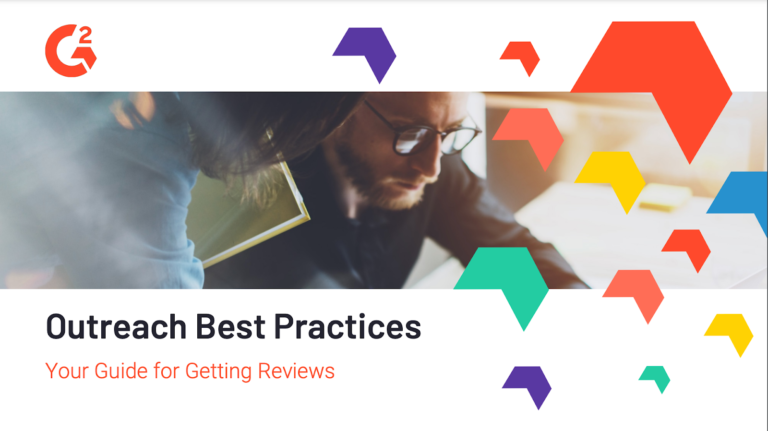
The secondary review generation tactics, i.e. the ones that seem to be recommended by one or two of the business software review sites, are:
- Employee email signatures – Customer-facing staff use an email signature with a review request as the call-to-action.
- Customer support communications – Support staff ask users to review after resolving their support tickets.
- Customer-facing team contests – Customer-facing teams ask the users they work with directly for reviews and get rewarded.
- Social media posts – Marketing posts ask their users to write them a review.
- Customer calls, emails, Slack messages, and other 1:1 communication channels – Customer-facing teams leverage the communication channel they see best fit to ask a user for a review.
- On your website – Marketing adds a review request call-to-action, such as on a Customers page.
- Customer Advisory Board (CAB) – Whoever runs the CAB asks the CAB members to provide a review.
- Supplement existing marketing campaigns with review requests – Customer Marketing weaves in review requests as secondary calls to action into their campaigns, such as in upselling and cross-selling focused campaigns.
Examples of how to generate reviews
Thousands of B2B SaaS companies generate user reviews, but finding real examples of how these companies generate reviews is a time-consuming challenge.
So here’s a round-up of some examples I’ve found that I think would help those in B2B SaaS review generation. Also, I’ve provided a deep dive into one of my own experiences with review generation.
Use NPS scores to trigger review requests – Alyce Example
Nick Bennett, former Director of Evangelism & Customer Marketing at Alyce, shared how he generated 73 new G2 reviews in 2 days with a simple yet effective approach with a slight twist.
Another NPS to review request example – ChurnZero
TrustRadius shared an example of a 3-step automation review request automation with ChurnZero:
- Send out NPS surveys
- Create a rule that if NPS response AND no TrustRadius review, then add to list to ask for a review
- Send email and/or in-app notification to ask for a review.
This approach helped ChurnZero increase the number of their product reviews on TrustRadius by 49% in three months.
NPS scores to trigger review requests with an optional filter – CloudApp example
A common add-on to the logic of a review automation workflow, like the previous example from ChurnZero, is to add a minimum Net Promoter (NPS) score.
Whether to add this step goes back to who to ask for reviews. It’s not uncommon for SaaS companies to add an NPS score of 9 or 10 (out of 10) – i.e. the “promoters” – as a filter for review request emails. For those that respond with an NPS score of 8 or lower, those can be routed to Product and Customer Success to look into any issues that may be leading to the user scoring as a “passive” (7 or 8 NPS) or a “detractor” (6 or less NPS), and address those issues before encouraging them to leave a review.
CloudApp generated 275 reviews in 6 months by triggering email review requests to users who did one of the following:
- NPS score of 8 or more
- Hit an activation success milestone
That’s it. Technically, CloudApp used Delighted (for NPS capture) and Customer.io (for event-triggered emails. Still, neither is a requirement to take the approach of generating reviews based on NPS scores or hitting a customer milestone. However, the tools would help automate the process at scale.
Use automated feedback surveys to uncover more review candidates – Instapage
Instapage (landing page software) created automated processes to gather more customer feedback through a tool called SatisMeter (customer feedback software used by over 250 SaaS companies worldwide).
Through SatisMeter, Instapage sent automated feedback request messages to their users based on time-based milestones post signup: during a trial, at two weeks, at three months, and 11 months post signup. These automated messages would go beyond the standard NPS question by asking four additional questions about Instapage on a 1–5 rating scale: the ease of use, the power of the features, the cost, and the quality of our support.
By gathering more customer feedback, Instapage was able to identify more of its promoters, which led to a 3x increase in reviews on sites like Trustpilot, Capterra, and G2.
This approach has enabled Instapage to prominently feature this G2 section on the Instapage homepage to help build trust in their solution.
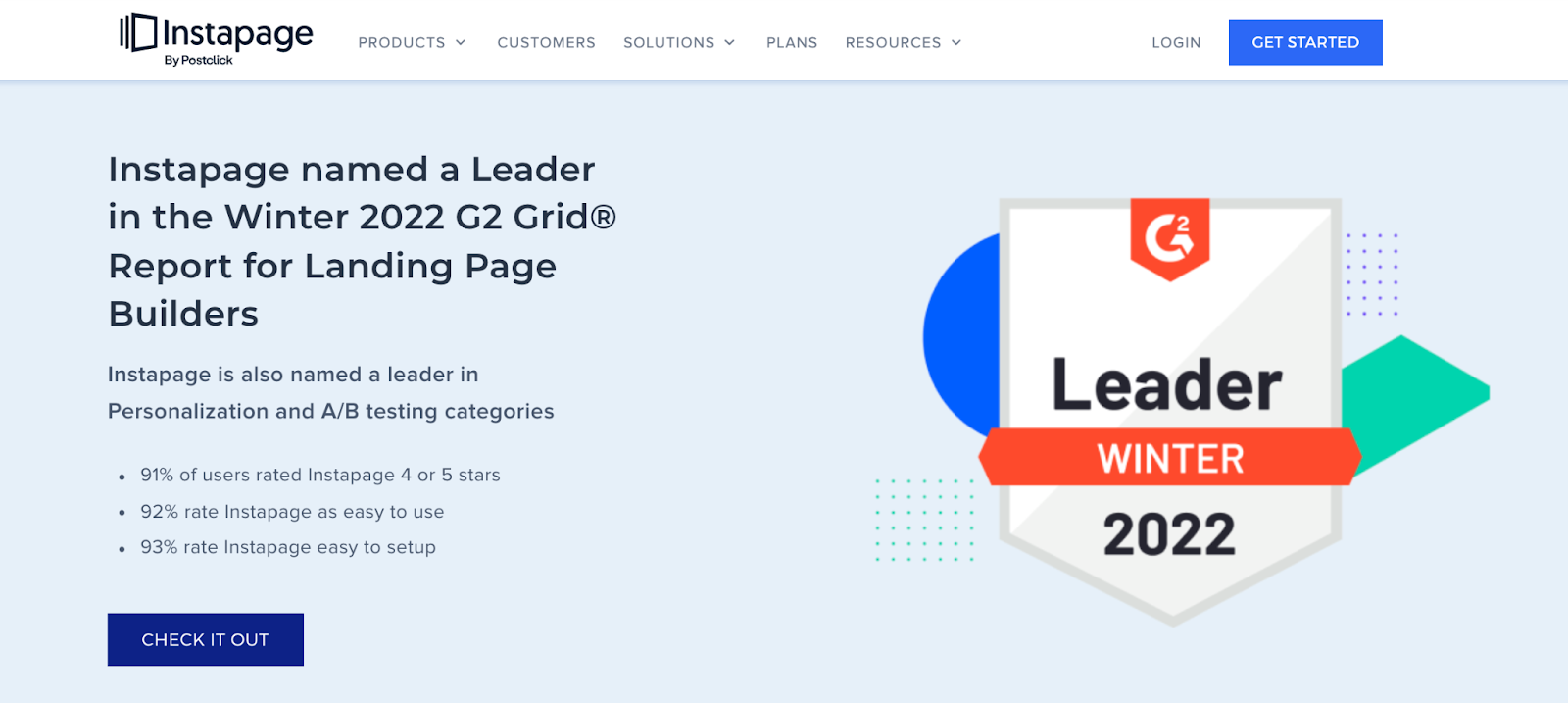
Ask for two reviews and offer incentives for each – CaptivateIQ example
CaptivateIQ (Sales Commission Software) emails customers requesting reviews on G2 and Capterra using separate CTA buttons and gift card offers.
This approach gives the review request recipient the chance to provide a second review while they’re at and be rewarded.
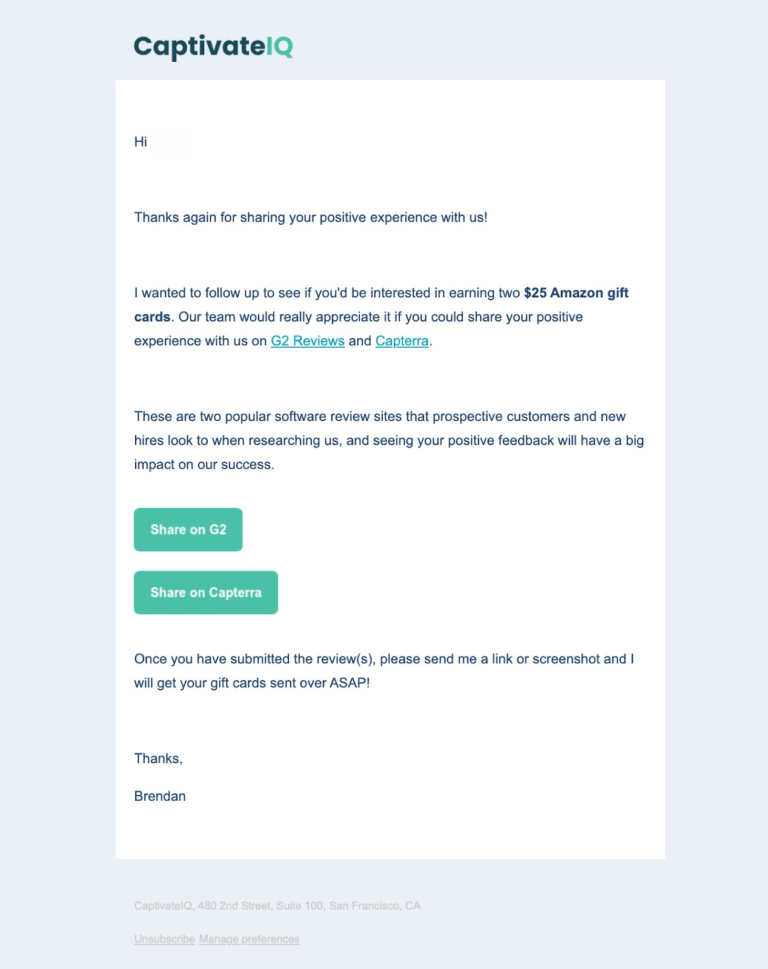
Ask for three reviews and offer incentives for each – Webex Events (Formerly Socio) example
Webex Events (Event Management Software) emailed customers requesting reviews on G2, Capterra, and TrustRadius.
This approach offers both the vendor (Webex Events) and the review candidates (their customers) a 3-for-1 offer. For Webex Events, it can generate three reviews from one reviewer. For the review candidate, it can earn $50 per review, yet can re-purpose much of the content from the first review in the other two reviews.
A simple form helps the review candidates easily tell Webex events where they’ve left a review.

Webex Events followed up with a second email request two days later, using the subject line, “REMINDER: $50 Amazon gift card for writing a review!”
Automate email review invitations – Wonderbly Example (B2C)
While this post focuses on B2B SaaS, here’s a review request email example from an eCommerce company, Wonderbly (a technology and publishing business that makes personalized books for children and adults) that can still help those in B2B SaaS.
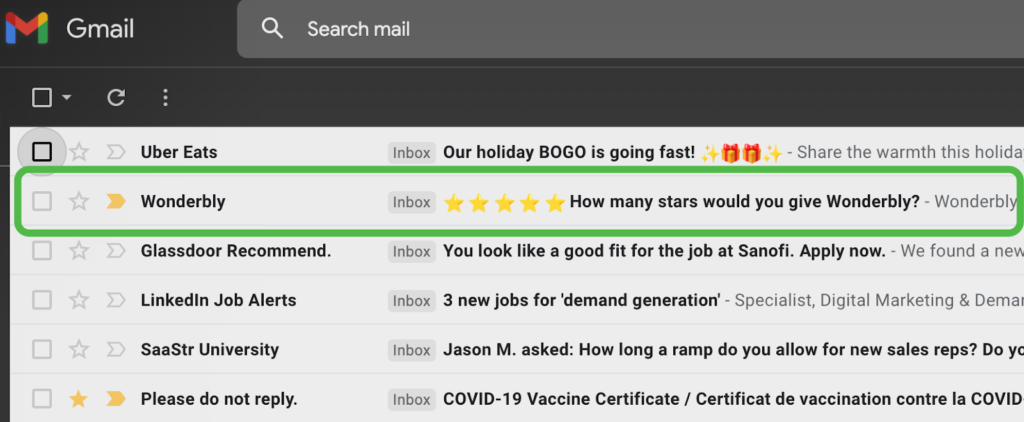

This review request email by Wonderbly does a lot well:
- They’ve automated the email send to be triggered by a customer milestone to help ask for a review at the right time (in this case, 2-3 weeks post-purchase and delivery to allow for enough time to form an opinion on the product)
- The subject line uses 5-star emojis to stand out in the inbox to increase email open rates
- The 5-star emojis also subtly prime the recipient to think 5 stars when considering the question in the subject line, “How many stars would you give Wonderbly?”
- They thank the customer for their purchase on Wonderly to show appreciation and remind them of their purchase.
- To raise credibility, they position the review request to improve customer satisfaction and leverage a third-party review site, Trustpilot.
- It makes it easy to pick a star rating by displaying the five options, and when the recipient clicks on any of the star ratings, it takes them to a review page that pre-populates their star rating based on what they selected in the email.
- End the email by saying that all reviews, “good, bad, or otherwise,” will show immediately, clarifying that all reviews will be treated equally.
As you can see on Wonderbly’s Trustpilot profile, it’s worked wonders for them, with 24,366 reviews and a 4.6 rating while asking all customers for reviews.

In 12 months, these automated invitations account for over 95% of Wonderbly reviews on Trustpilot.
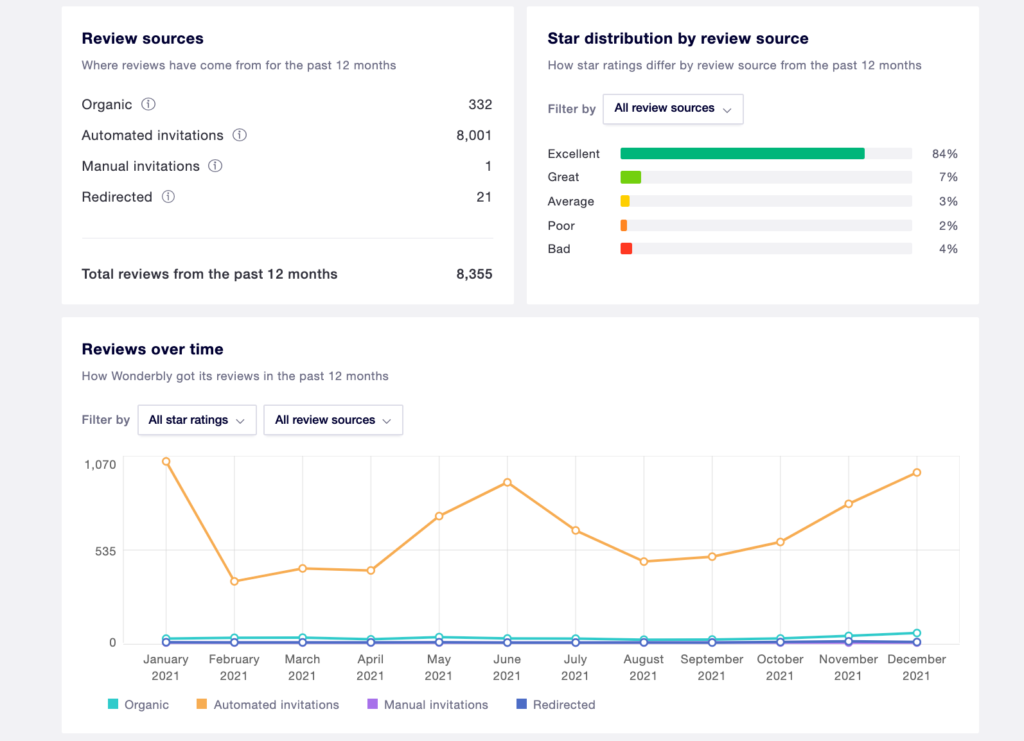
In-app online review requests – Gong, Auvik, and IBM Cloud
If you’re in a go-to-market role at a company that uses Gong (Sales Intelligence Software), you’ve likely seen this in-app message (see screenshot) to write a review on Gong to get a $10 gift card.
Gong was rated #1 in G2’s Best Software Products of 2022 (and 2021). To top the charts, in the calendar year of 2021, Gong consistently drove dozens of reviews on G2 each month, with some added review spikes throughout the year.
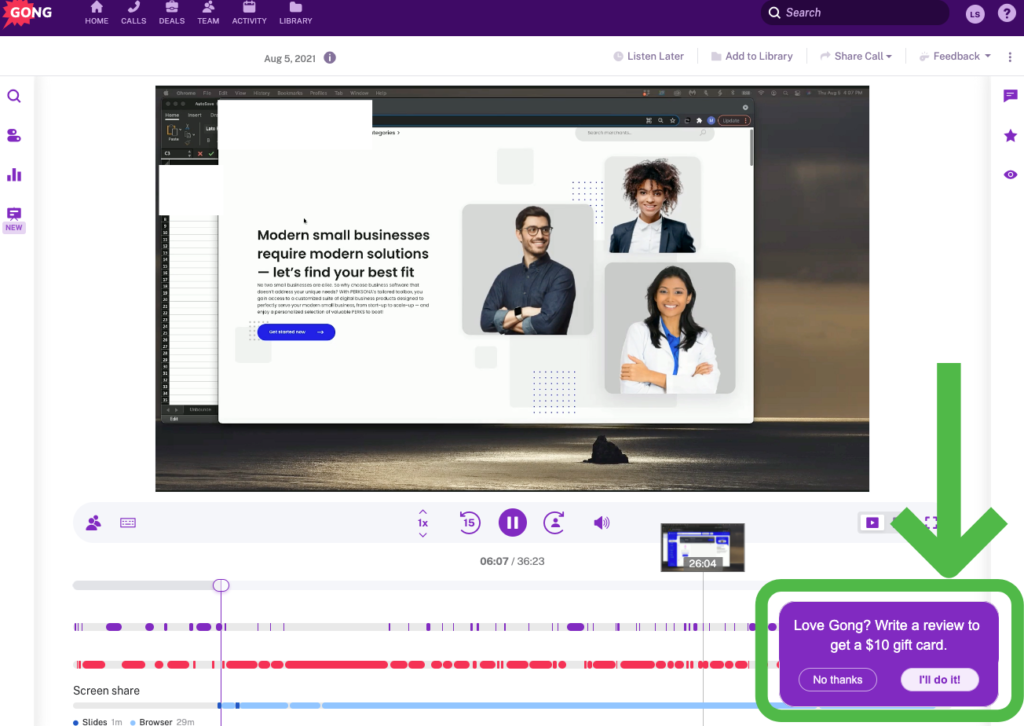
IBM, an even bigger tech giant, also uses in-app review requests for IBM Cloud. Shannon Cardwell, Peer Review Program Manager at IBM, said these in-app review requests have been “wildly successful for us in terms of sourcing reviews on an ongoing basis” on the TrustRadius webinar, 5 Ways IBM Uses Reviews to Power their Marketing Machine.
This approach has been one way that IBM Cloud has generated over 3,000 reviews across 80 products on TrustRadius.

Another way to generate reviews is to ask your users to provide a review when they’re about to use your software. You can do so by requesting a review on your application’s login page, as Auvik is asking for G2 reviews.
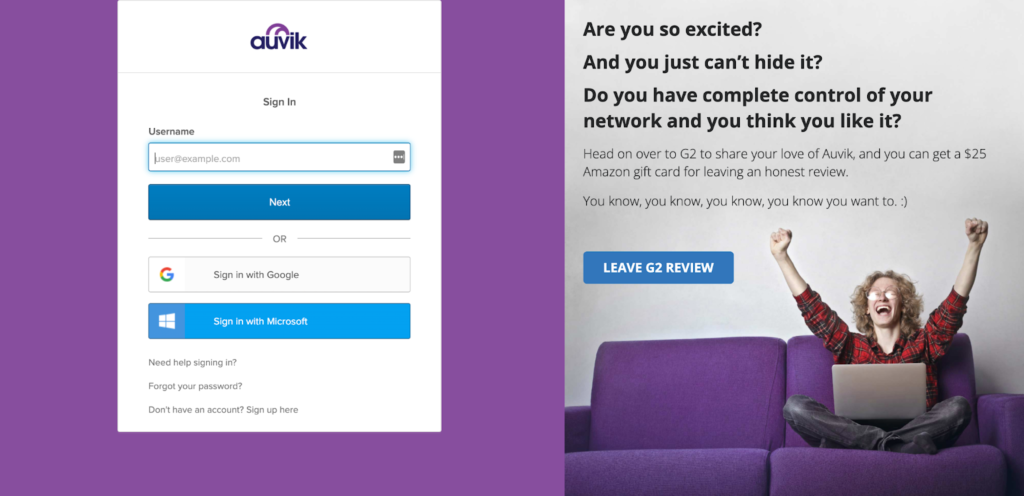
In user community review requests – Ada
Another place where your users interact with your company is in your user community. In the Ada (conversational intelligence chatbot software) ACX Community, their community manager has a pinned post asking customers for a review.
Ada’s review request creates a sense of urgency by providing a limited-time offer (“Between now and March 1st”). It also uses scarcity (i.e. “we’ll send the first 25 reviewers a $25 Amazon gift card”) to further persuade potential reviewers to act now.
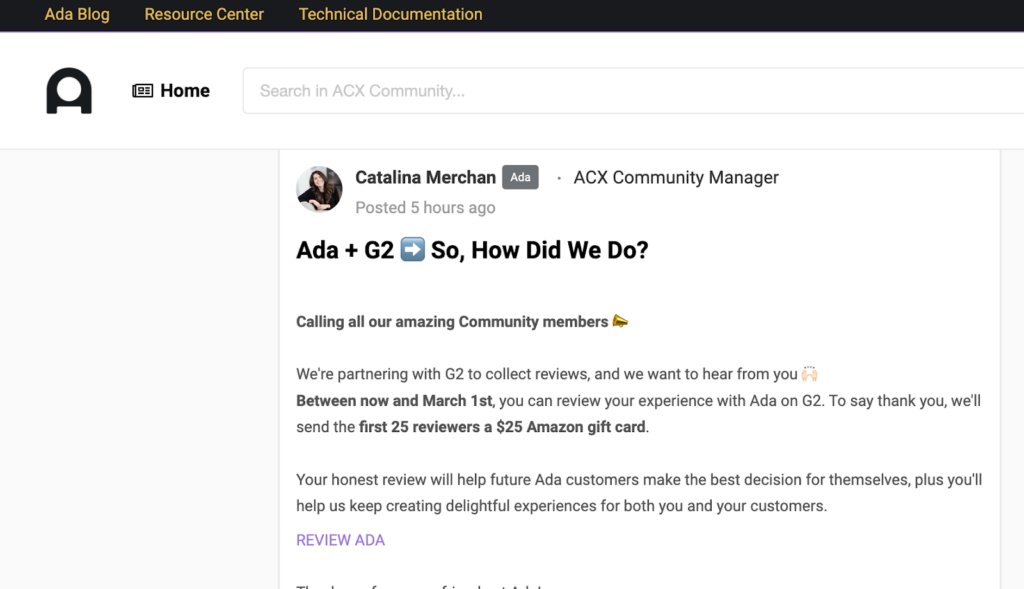
Review booths at user conference events – Hopin and Oracle Analytics
For companies large enough to host user conferences, a review booth at a user conference can be a great way to generate reviews.
Oracle Analytics had a G2 review booth at Kscope, a 3,000 person Oracle user group event, and they generated 154 reviews in two days, a 200% increase in reviews.
Hopin (now RingCentral Events) teamed up with G2 on a G2 review booth at Illuminate 2021, a Hopin user conference with 10,000+ attendees. They created a special offer: leave a review of Hopin, get a $25 Amazon gift card, and G2 will donate $10 to Girls Who Code for every review collected.
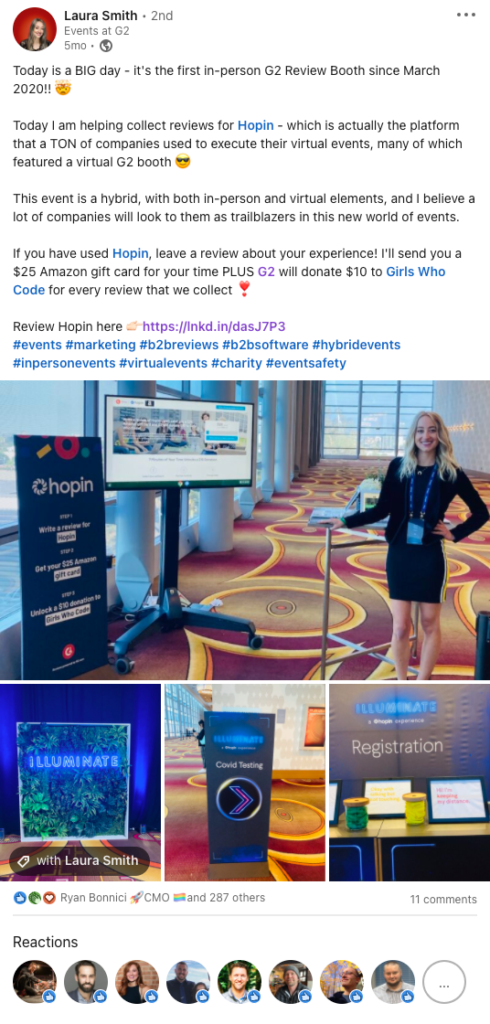
Offer product credits for online reviews – SurferSEO
A novel way to generate online reviews is to offer users product credits in exchange for writing online reviews.
For example, SurferSEO has an in-app call-to-action for a “Surfer Credits Giveaway.” The giveaway is a gamified experience experience in which a user gets Surfer credits in exchange for writing reviews on G2, Capterra, and Trustpilot.
This approach would best suit SaaS companies with usage-based pricing.
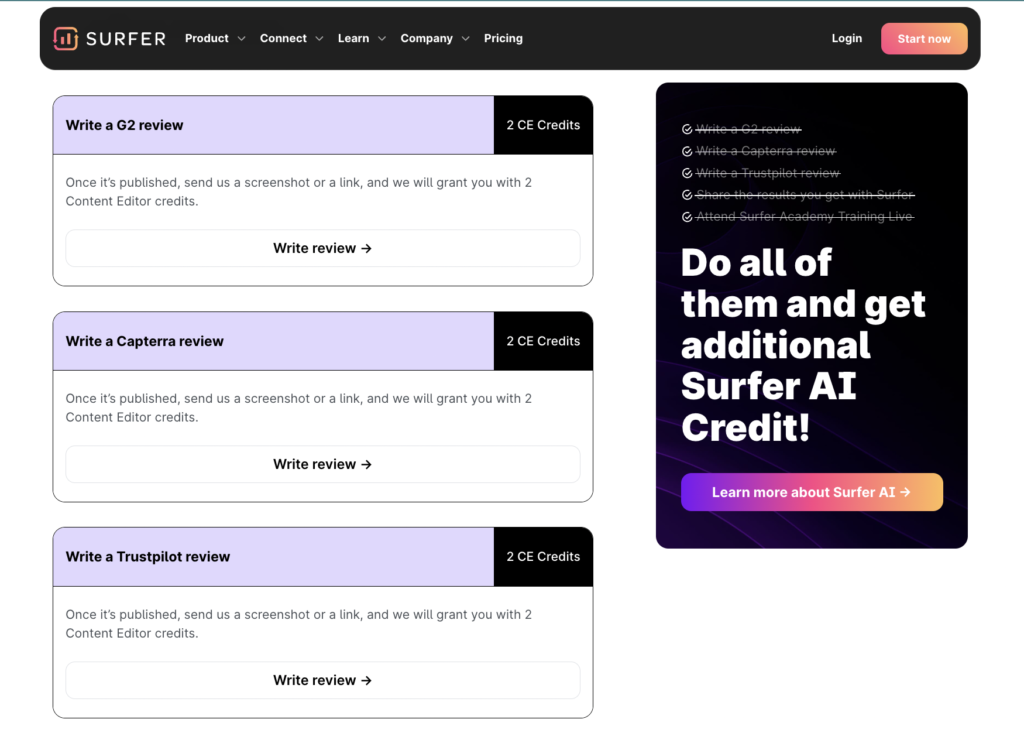
Testimonials into reviews – Testimonial Hero and Crowdvocate
Great reviews make for great testimonials and vice versa.
Sam Shepler, CEO of Testimonial Hero, shared a tip from Ari Hoffman, Vice President of Customer Marketing & Advocacy at Influitive, to use the transcript of a video testimonial as review content material that you could feed to a review candidate in a request for review. For more, here’s how Sam tells it:
Customer advocacy program-driven review examples
While working at Influitive (the Advocate Marketing category creator), I learned much about how advocates drive The 3 Rs of Customer Advocacy: reviews, references, and referrals.
Here is a roundup of some of the most helpful stories from Influitive about how B2B companies generate user reviews.
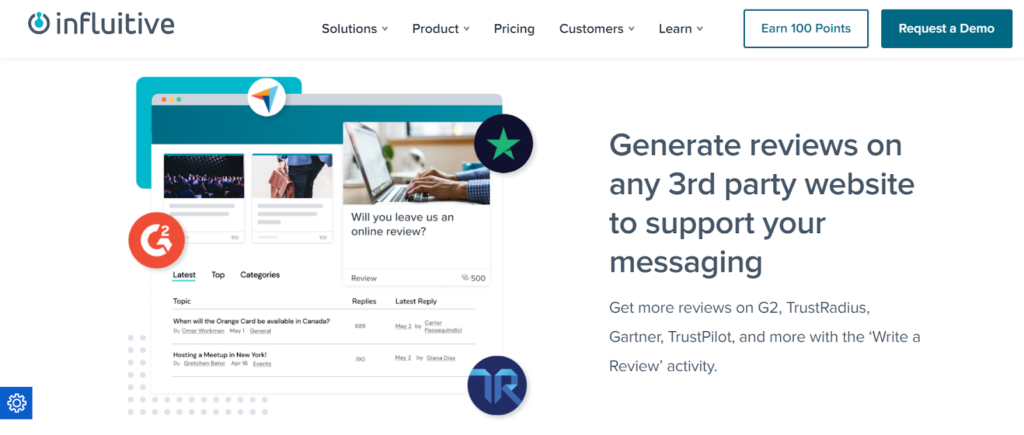
Wrike
From a 2018 G2 and Influitive benchmark study, The Impact of Advocate Marketing on Product Reviews, Wrike, had a respectable 31 reviews and was situated as a High Performer for project management software products on November 4, 2014. But by creating a “Write a G2 Review” achievement in their Influitive module, they gathered more than 100 reviews in 24 hours.
Note: an Influitive module like this would offer an advocate points to provide a review. Influitive points are a currency used for branded swag, gift cards, etc. The points are also are used in gamified leaderboards to show recognition. In this example, a module would represent an ask or a challenge from the vendor, Wrike, to its advocates to write a review in exchange for points.
Wrike generated many more reviews, having over 1,300 reviews by March 2021, when Citrix acquired it for $2.25 billion.
PowerDMS
PowerDMS (Policy Management Software) generated 230 online reviews on third-party review sites by engaging advocates in the product feedback process and then asking for reviews once the advocates have invested in the product direction.
To encourage participation, PowerDMS gamified the experience. Gamifying review generation typically entails providing points to users and getting others to write reviews. These points could be displayed on a leaderboard to create a sense of competition, ego boost, and clout in the user community.
Marketo
In 2015, Marketo was looking to become the #1 marketing automation platform on review sites in the enterprise segment, a spot owned by Eloqua, which had a larger proportion of enterprise customers.
So Marketo offered their customer advocates at enterprise accounts coveted swag through a gamified experience to entice them to provide reviews. The results were remarkable:
Marketo received 538 net-new reviews across G2 Crowd (340), TrustRadius (145), Software Advice (28) and AppExchange (25). They also gained the #1 position on G2 Crowd within the Enterprise segment, the #1 spot on TrustRadius in the Mid-Market and Enterprise segments, and was dubbed the “Most Reviewed in 2015” on G2 Crowd.
This result helped Marketo challenge the perception in the market that Marketo was only for SMB and Mid-Market companies. In doing so, they acquired more enterprise customers, presumably important to Adobe when it acquired Marketo in 2018 for $4.75 billion.
Monetate (now KIBO)
A recurring theme with review generation is timing. If you haven’t connected with a user in a while and then ask for a review, your chances of getting one are less than if you ask them after a recent interaction.
Monetate (now KIBO) demonstrated the importance of review request timing in this post on How Advocates Made Monetate the Leader on Software Review Sites.
Influitive interviewed then Head of Customer Advocacy at Monetate, Brett Bair, on how they went from off-the-grid to a leader. “Asking customers for reviews is like asking friends to help you move,” says Brett. “If you haven’t seen people in a while, they probably won’t want to help you. However, if you keep in touch – and provide pizza and beer – they’ll be more likely to help out.”
Wiley
Influitive interviewed their customer, Wiley, and asked how Wiley uses advocates to write reviews for them on G2. Wiley responded, “Weave the (review) ask into one or more of our strategic campaigns. For example, right before COVID began, we did a PI Day campaign where we said we would give members (advocate users) a gift card to a pizza place in exchange for writing a review. Our advocates could choose which restaurant they wanted a gift card to, and the results were fantastic.”
Acuity Scheduling (now part of Squarespace)
Acuity Scheduling generated 70 online reviews in a week on the QuickBooks App Store by running a contest.
They launched an in-product pop-up inviting their customers to review their app on the QuickBooks App Store. In exchange, everyone who did so would be entered into a random draw to win one year of the product – a great bargain for a small business. This campaign generated over 70 reviews for their app in just one week.
While this Acuity Scheduling example dates back to 2017, as of February 2022, this still accounts for almost half of their 147 reviews on the QuickBooks App Store).
PartnerStack – A firsthand example of review generation
When I joined PartnerStack (Partner Management and Affiliate Marketing software for B2B SaaS) in March 2020 to work on their demand generation, one of the first things we prioritized was review generation.
At that time, PartnerStack had 40 reviews on G2, was in the Niche quadrants of the Partner Management Software category and Affiliate Marketing Software categories, and was ranked 9th of 11 vendors.
At this point, PartnerStack had a customer base of over 200 SaaS companies, with happy customers at well-known SaaS companies such as Intuit, Asana, and Evernote.
So, we set a Summer 2020 goal to move beyond the Niche quadrant into the Leader quadrant. While that may be a mega leap for some vendors, depending on the reviews landscape in your category, at PartnerStack, it was attainable.
We assembled a small cross-functional team that tackled reviews above and beyond each of our primary responsibilities. Fortunately, we found some early success that enabled us to move up faster in the ranks than anticipated and ultimately earned the executive buy-in to continue our drive for reviews.
Quick aside: you may wonder why it mattered to PartnerStack how G2 ranked it.
In short, it mattered because 1,361 companies had researched Partner Management Software or Affiliate Marketing software on G2 in 90 days (March 19, 2020, to June 17, 2020). G2 has the top organic search engine result for “partner management software” and one of the top results on “affiliate software,” so it attracts many buyers in the market for this software. Many of these buyers come from the types of companies that use PartnerStack (mainly B2B SaaS companies). This web traffic data meant that PartnerStack’s buyers turned to G2, making G2 important to PartnerStack.
Also, there continues to be a high growth rate of buyers researching these categories on G2. When we look at a recent 90-day period (November 18, 2021, to February 16, 2022), 4,325 companies had researched the same categories—Partner Management Software or Affiliate Marketing software on G2—more than a 3x increase in potential buyers (companies) over the 90-day window March 19, 2020, to June 17, 2020.

Back to the goal of generating reviews to move into the Leaders quadrant, the solution lies in getting more G2 reviews and reviews with high satisfaction scores.
How PartnerStack generated more G2 reviews
Since June 2020, PartnerStack has generated reviews in the following ways:
NPS responses to trigger an automated email
As many B2B SaaS companies do, PartnerStack used an NPS-to-G2 review request automated workflow as part of a wider review generation process.
Automated email blast: send a review request on behalf of CSMs
To help save the CSMs time, we tried sending a batch email out to review candidates who used HubSpot smart content to personalize the email signature with that of the CSM listed on the account. Unfortunately, this test failed to generate results.
Quarterly review deadline push: manual 1:1 Asks
In addition to the automated review request workflow, PartnerStack also made a manual effort, particularly near the end of a quarter, to make 1:1 review requests weaved naturally into PartnerStack CSM conversations with customers.
CS and Partnerships identified some review candidates that they wanted to ask directly. This method remarkably effectively generated reviews: more than one-third of review requestees provided a review. So, as a last resort, we turned to good old-fashioned one-to-one requests. Various PartnerStack employees with relationships with our users made direct asks for reviews.
We saw success with this 1:1 manual ask from our people asking for reviews in multiple channels, from email to Slack to Zoom calls.
One employee said, “I normally find for anything like this, email + social (Slack/LinkedIn msg) works well… Email is easier to pitch like a robot, and just hammer, but social (media) makes them remember you’re a human lol”.
Milestone-driven review requests: Onboarding completion and CSATs
We also looked beyond NPS scores to identify other milestones to trigger review requests. One of these milestones was the end of customer onboarding.
We made end-of-onboarding requests in two ways. The first was a review request woven into an email on the handoff from the Onboarding team to the Customer Success team. The second was when the new user provided a CSAT (Customer Satisfaction) Score. If the customer responded to the post-onboarding CSAT survey, that would trigger a review request.
Tiering review candidates and taking different approaches
We also found success in tiering based on the strength of our relationship with them. For our closest users, we continue to make 1:1 personalized review requests. For our broad base of users, we have automated our review request process, leveraging milestone-based triggers and incentives like gift cards to encourage user reviews when they’re in the right frame of mind to do so.
Automated NPS-to-Review Request Process + End-of-Quarter Manual Push
When considering manual vs. automated review requests, there are pros and cons to each.
A manual approach allows you to personalize the ask and wait for the right moment to ask, but it’s time-intensive and hard to sustain. Conversely, an automated approach saves you time to sustain an always-on approach to review generation, but it lacks a personal touch.
One middle ground is to automate the nudge to the review requester at your organization, like a CSM, rather than the review request itself. You can set up automated triggers based on user milestones that remind the review requester (CSM) to request the review at the right time. It also enables the added personal touch that a manual approach can afford, like waiting to ask for the review until the meeting between the CSM and the user review candidate.
You can leverage marketing automation platforms to create workflows with if/then logic for automation. For example, if someone is added to a list (because they triggered a user milestone like an NPS response, renewal, etc.), you can create a workflow that sends them a review request. If they don’t respond within a certain period (say one week), send an automated follow-up review request reminder.
Zapier can be a big help in tying your systems together.
Say you have NPS data in Wootric, HubSpot as your marketing platform, G2 as your main review platform, and Slack as your internal communication platform. You can use Zaps to create a workflow that triggers HubSpot to add an NPS respondent to a list used to send an email request. If it leads to a G2 review, the G2 review data is sent to a Slack channel to inform your team of the review.
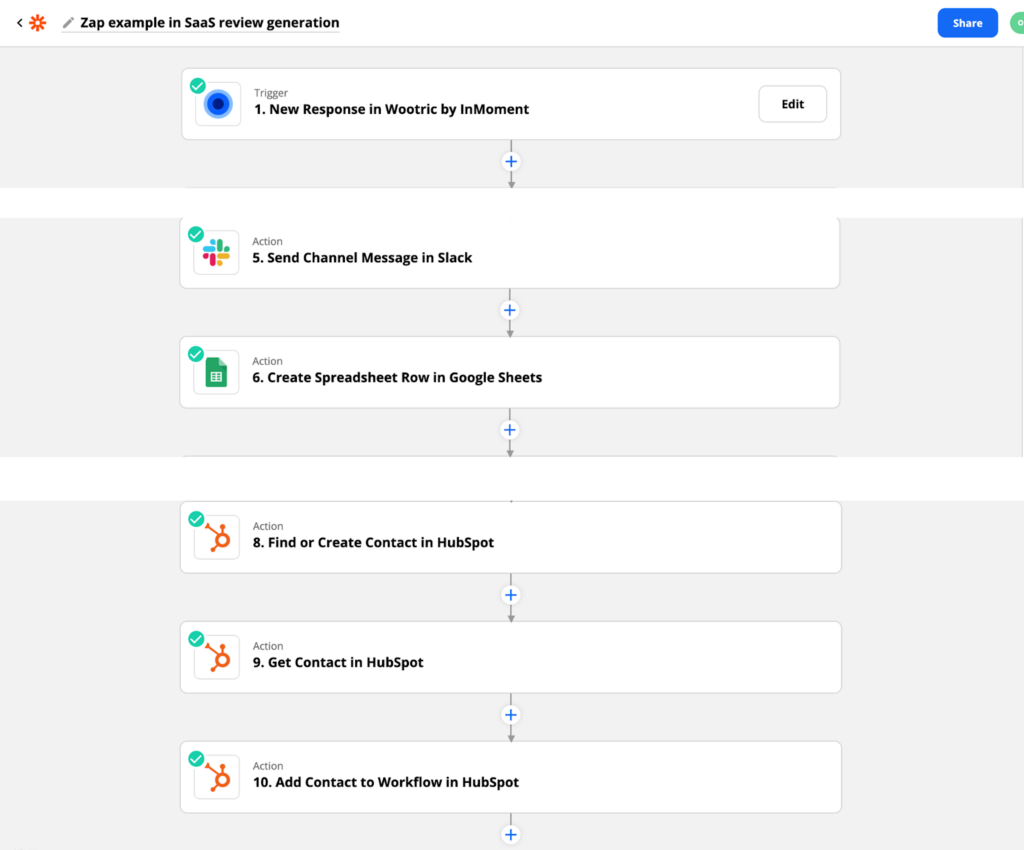
Alternatively, you can use the NPS response to trigger the message to a Slack channel and tag the right person, like a CSM, to ask for a review manually with a personal touch.
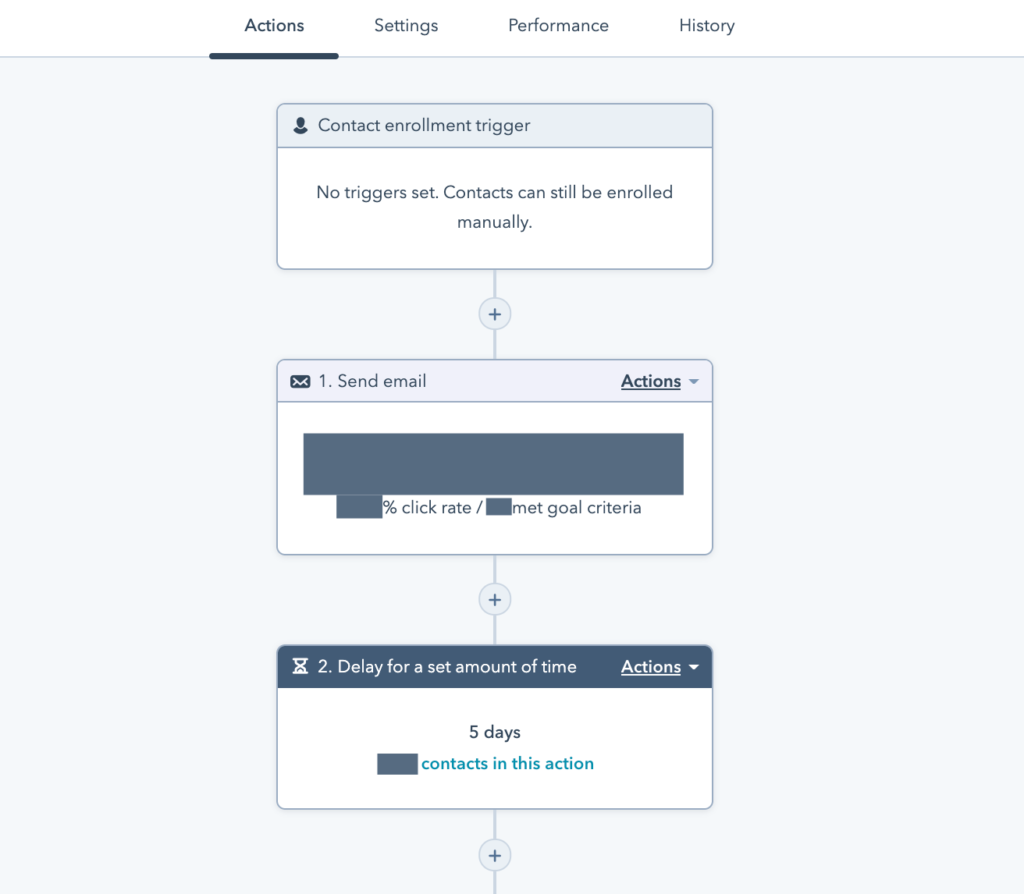
Notes:
- In this HubSpot workflow example, there are “no triggers set” for the “contact enrollment trigger” because “you don’t need to set enrollment triggers if you’ll only be manually enrolling records in a workflow or enrolling records through another workflow’s Enroll in another workflow action.” In this example, the Zap adds the contacts (Step 10 – Add Contact to Workflow in HubSpot).
- I have intentionally omitted and blurred details of the automation featured, but the examples should give you a sense of what you can do with review automation.
In 2021, we added renewals as a milestone to trigger review requests (vetted by CS).
We’re also finding success using milestones like providing an NPS score as triggers for a member of our new Customer Marketing function to make the review request on behalf of the company. A vital part of the review request message is to thank them for being our customer and allowing us to be a part of their partnership journey. It’s been great to see their growth and what they’ve been able to achieve with PartnerStack.
Summing up the PartnerStack review generation approach
Ultimately, we’ve found an approach to review generation that balances asking the right people at the right time in the right way. This balanced approach uses manual and automated processes triggered by multiple milestones to request reviews across multiple channels.
The approach will vary by company and team. So, after reviewing posts like this one, the next best thing to do is give it a go and adapt to your situation as needed.
Follow-up with review candidates with answers to common objections to review writing
Some of your users would be willing to give you a review if they had some of their unspoken objections addressed.
These unspoken objections are the questions we ask ourselves when asked to give a review. Questions like, How long will this take? Can I provide a review anonymously? Will I get this incentive if I give a review?
One of HubSpot’s tips for getting reviews from users is to let them know how long it will take.
Here’s an example from PartnerStack of some of the objections to providing a review that we included in a follow-up message to review candidates who hadn’t provided a review:

Recapping How to Generate Online Reviews in B2B Software
Common components of online review generation success:
- Ask at the right time: whether you lead with an NPS survey or wait for a customer success milestone, asking your users for a review shortly after they have had a marker of success can often lead to review success.
- Provide incentive: it’s common practice in B2B software to incentivize the reviewer. The incentive can come from the review site, the vendor to the reviewer, and the vendor to the employee who asked the user for the reviews. Keeping up with your competition will likely be challenging if you choose not to provide incentives, though every software vendor differs. You may have the luxury of choice if you have a mega-sized user base. For many software vendors, you’ll need incentives.
- Try multiple channels: While email seems to be the top channel for review requests, vendors have found success asking for reviews in-app, on Zoom calls, in LinkedIn and Slack messages, in-app, and elsewhere.
- Use a personal touch: While automation can play an important role in review generation, especially at scale, don’t lose sight of the power of personal relationships and the human touch. Users may be more likely to respond if they know someone has taken the time to ask them personally for the review.
More how-to resources to generate online reviews
- TrustRadius Review Growth Kit
- Get email templates, social media images, email signatures, embedded invitations, and TrustRadius rating badges.
- G2 Resources
- Get a “Review Campaign in a Box” and other how-to resources.
- G2 recently built G2 University to help educate SaaS sellers in all things review.
- Gartner Digital Markets
- Captivate Collective
- Five Star Strategies For Online Reviews – a best practice ebook on collecting, managing, and publishing online user reviews in B2B software.
- NPS Templates:
- SurveySparrow NPS survey templates #1 and #2
- JotForm NPS survey template (form-templates/net-promoter-score-form)
- Delighted by Qualtrics NPS survey
- Typeform NPS Survey template
- For eCommerce vendors
- 6 Ways to Generate More Customer Reviews for eCommerce Businesses by Drip
- For B2B Service Providers:
- For local businesses:
Examples of how to generate reviews
Thousands of B2B SaaS companies generate user reviews, but finding real examples of how these companies generate reviews is a time-consuming challenge.
So here’s a round-up of some examples I’ve found that I think would help those in B2B SaaS review generation. Also, I’ve provided a deep dive into one of my own experiences with review generation.
Use NPS scores to trigger review requests - Alyce Example
Nick Bennett, former Director of Evangelism & Customer Marketing at Alyce, shared how he generated 73 new G2 reviews in 2 days with a simple yet effective approach with a slight twist.
Another NPS to review request example - ChurnZero
TrustRadius shared an example of a 3-step automation review request automation with ChurnZero:
- Send out NPS surveys
- Create a rule that if NPS response AND no TrustRadius review, then add to list to ask for a review
- Send email and/or in-app notification to ask for a review.
This approach helped ChurnZero increase the number of their product reviews on TrustRadius by 49% in three months.
NPS scores to trigger review requests with an optional filter - CloudApp example
A common add-on to the logic of a review automation workflow, like the previous example from ChurnZero, is to add a minimum Net Promoter (NPS) score.
Whether to add this step goes back to who to ask for reviews. It’s not uncommon for SaaS companies to add an NPS score of 9 or 10 (out of 10) – i.e. the “promoters” – as a filter for review request emails. For those that respond with an NPS score of 8 or lower, those can be routed to Product and Customer Success to look into any issues that may be leading to the user scoring as a “passive” (7 or 8 NPS) or a “detractor” (6 or less NPS), and address those issues before encouraging them to leave a review.
CloudApp generated 275 reviews in 6 months by triggering email review requests to users who did one of the following:
- NPS score of 8 or more
- Hit an activation success milestone
That’s it. Technically, CloudApp used Delighted (for NPS capture) and Customer.io (for event-triggered emails. Still, neither is a requirement to take the approach of generating reviews based on NPS scores or hitting a customer milestone. However, the tools would help automate the process at scale.
Use automated feedback surveys to uncover more review candidates - Instapage
Instapage (landing page software) created automated processes to gather more customer feedback through a tool called SatisMeter (customer feedback software used by over 250 SaaS companies worldwide).
Through SatisMeter, Instapage sent automated feedback request messages to their users based on time-based milestones post signup: during a trial, at two weeks, at three months, and 11 months post signup. These automated messages would go beyond the standard NPS question by asking four additional questions about Instapage on a 1–5 rating scale: the ease of use, the power of the features, the cost, and the quality of our support.
By gathering more customer feedback, Instapage was able to identify more of its promoters, which led to a 3x increase in reviews on sites like Trustpilot, Capterra, and G2.
This approach has enabled Instapage to prominently feature this G2 section on the Instapage homepage to help build trust in their solution.
Ask for two reviews and offer incentives for each - CaptivateIQ example
CaptivateIQ (Sales Commission Software) emails customers requesting reviews on G2 and Capterra using separate CTA buttons and gift card offers.
This approach gives the review request recipient the chance to provide a second review while they’re at and be rewarded.

Ask for three reviews and offer incentives for each - Webex Events (Formerly Socio) example
Webex Events (Event Management Software) emailed customers requesting reviews on G2, Capterra, and TrustRadius.
This approach offers both the vendor (Webex Events) and the review candidates (their customers) a 3-for-1 offer. For Webex Events, it can generate three reviews from one reviewer. For the review candidate, it can earn $50 per review, yet can re-purpose much of the content from the first review in the other two reviews.
A simple form helps the review candidates easily tell Webex events where they’ve left a review.

Webex Events followed up with a second email request two days later, using the subject line, “REMINDER: $50 Amazon gift card for writing a review!”
Automate email review invitations - Wonderbly Example (B2C)
While this post focuses on B2B SaaS, here’s a review request email example from an eCommerce company, Wonderbly (a technology and publishing business that makes personalized books for children and adults) that can still help those in B2B SaaS.


This review request email by Wonderbly does a lot well:
- They’ve automated the email send to be triggered by a customer milestone to help ask for a review at the right time (in this case, 2-3 weeks post-purchase and delivery to allow for enough time to form an opinion on the product)
- The subject line uses 5-star emojis to stand out in the inbox to increase email open rates
- The 5-star emojis also subtly prime the recipient to think 5 stars when considering the question in the subject line, “How many stars would you give Wonderbly?”
- They thank the customer for their purchase on Wonderly to show appreciation and remind them of their purchase.
- To raise credibility, they position the review request to improve customer satisfaction and leverage a third-party review site, Trustpilot.
- It makes it easy to pick a star rating by displaying the five options, and when the recipient clicks on any of the star ratings, it takes them to a review page that pre-populates their star rating based on what they selected in the email.
- End the email by saying that all reviews, “good, bad, or otherwise,” will show immediately, clarifying that all reviews will be treated equally.
As you can see on Wonderbly’s Trustpilot profile, it’s worked wonders for them, with 24,366 reviews and a 4.6 rating while asking all customers for reviews.

In 12 months, these automated invitations account for over 95% of Wonderbly reviews on Trustpilot.

In-app online review requests - Gong, Auvik, and IBM Cloud
If you’re in a go-to-market role at a company that uses Gong (Sales Intelligence Software), you’ve likely seen this in-app message (see screenshot) to write a review on Gong to get a $10 gift card.
Gong was rated #1 in G2’s Best Software Products of 2022 (and 2021). To top the charts, in the calendar year of 2021, Gong consistently drove dozens of reviews on G2 each month, with some added review spikes throughout the year.

IBM, an even bigger tech giant, also uses in-app review requests for IBM Cloud. Shannon Cardwell, Peer Review Program Manager at IBM, said these in-app review requests have been “wildly successful for us in terms of sourcing reviews on an ongoing basis” on the TrustRadius webinar, 5 Ways IBM Uses Reviews to Power their Marketing Machine.
This approach has been one way that IBM Cloud has generated over 3,000 reviews across 80 products on TrustRadius.

Another way to generate reviews is to ask your users to provide a review when they’re about to use your software. You can do so by requesting a review on your application’s login page, as Auvik is asking for G2 reviews.

In user community review requests - Ada
Another place where your users interact with your company is in your user community. In the Ada (conversational intelligence chatbot software) ACX Community, their community manager has a pinned post asking customers for a review.
Ada’s review request creates a sense of urgency by providing a limited-time offer (“Between now and March 1st”). It also uses scarcity (i.e. “we’ll send the first 25 reviewers a $25 Amazon gift card”) to further persuade potential reviewers to act now.

Review booths at user conference events - Hopin and Oracle Analytics
For companies large enough to host user conferences, a review booth at a user conference can be a great way to generate reviews.
Oracle Analytics had a G2 review booth at Kscope, a 3,000 person Oracle user group event, and they generated 154 reviews in two days, a 200% increase in reviews.
Hopin (now RingCentral Events) teamed up with G2 on a G2 review booth at Illuminate 2021, a Hopin user conference with 10,000+ attendees. They created a special offer: leave a review of Hopin, get a $25 Amazon gift card, and G2 will donate $10 to Girls Who Code for every review collected.
Offer product credits for online reviews - SurferSEO
A novel way to generate online reviews is to offer users product credits in exchange for writing online reviews.
For example, SurferSEO has an in-app call-to-action for a “Surfer Credits Giveaway.” The giveaway is a gamified experience experience in which a user gets Surfer credits in exchange for writing reviews on G2, Capterra, and Trustpilot.
This approach would best suit SaaS companies with usage-based pricing.

Testimonials into reviews - Testimonial Hero and Crowdvocate
Great reviews make for great testimonials and vice versa.
Sam Shepler, CEO of Testimonial Hero, shared a tip from Ari Hoffman, Vice President of Customer Marketing & Advocacy at Influitive, to use the transcript of a video testimonial as review content material that you could feed to a review candidate in a request for review. For more, here’s how Sam tells it:
Customer advocacy program-driven review examples
While working at Influitive (the Advocate Marketing category creator), I learned much about how advocates drive The 3 Rs of Customer Advocacy: reviews, references, and referrals.
Here is a roundup of some of the most helpful stories from Influitive about how B2B companies generate user reviews.
Wrike
From a 2018 G2 and Influitive benchmark study, The Impact of Advocate Marketing on Product Reviews, Wrike, had a respectable 31 reviews and was situated as a High Performer for project management software products on November 4, 2014. But by creating a “Write a G2 Review” achievement in their Influitive module, they gathered more than 100 reviews in 24 hours.
Note: an Influitive module like this would offer an advocate points to provide a review. Influitive points are a currency used for branded swag, gift cards, etc. The points are also are used in gamified leaderboards to show recognition. In this example, a module would represent an ask or a challenge from the vendor, Wrike, to its advocates to write a review in exchange for points.
Wrike generated many more reviews, having over 1,300 reviews by March 2021, when Citrix acquired it for $2.25 billion.
PowerDMS
PowerDMS (Policy Management Software) generated 230 online reviews on third-party review sites by engaging advocates in the product feedback process and then asking for reviews once the advocates have invested in the product direction.
To encourage participation, PowerDMS gamified the experience. Gamifying review generation typically entails providing points to users and getting others to write reviews. These points could be displayed on a leaderboard to create a sense of competition, ego boost, and clout in the user community.
Marketo
In 2015, Marketo was looking to become the #1 marketing automation platform on review sites in the enterprise segment, a spot owned by Eloqua, which had a larger proportion of enterprise customers.
So Marketo offered their customer advocates at enterprise accounts coveted swag through a gamified experience to entice them to provide reviews. The results were remarkable:
Marketo received 538 net-new reviews across G2 Crowd (340), TrustRadius (145), Software Advice (28) and AppExchange (25). They also gained the #1 position on G2 Crowd within the Enterprise segment, the #1 spot on TrustRadius in the Mid-Market and Enterprise segments, and was dubbed the “Most Reviewed in 2015” on G2 Crowd.
This result helped Marketo challenge the perception in the market that Marketo was only for SMB and Mid-Market companies. In doing so, they acquired more enterprise customers, presumably important to Adobe when it acquired Marketo in 2018 for $4.75 billion.
Monetate (now KIBO)
A recurring theme with review generation is timing. If you haven’t connected with a user in a while and then ask for a review, your chances of getting one are less than if you ask them after a recent interaction.
Monetate (now KIBO) demonstrated the importance of review request timing in this post on How Advocates Made Monetate the Leader on Software Review Sites.
Influitive interviewed then Head of Customer Advocacy at Monetate, Brett Bair, on how they went from off-the-grid to a leader. “Asking customers for reviews is like asking friends to help you move,” says Brett. “If you haven’t seen people in a while, they probably won’t want to help you. However, if you keep in touch – and provide pizza and beer – they’ll be more likely to help out.”
Wiley
Influitive interviewed their customer, Wiley, and asked how Wiley uses advocates to write reviews for them on G2. Wiley responded, “Weave the (review) ask into one or more of our strategic campaigns. For example, right before COVID began, we did a PI Day campaign where we said we would give members (advocate users) a gift card to a pizza place in exchange for writing a review. Our advocates could choose which restaurant they wanted a gift card to, and the results were fantastic.”
Acuity Scheduling (now part of Squarespace)
Acuity Scheduling generated 70 online reviews in a week on the QuickBooks App Store by running a contest.
They launched an in-product pop-up inviting their customers to review their app on the QuickBooks App Store. In exchange, everyone who did so would be entered into a random draw to win one year of the product – a great bargain for a small business. This campaign generated over 70 reviews for their app in just one week.
While this Acuity Scheduling example dates back to 2017, as of February 2022, this still accounts for almost half of their 147 reviews on the QuickBooks App Store).
PartnerStack - A firsthand example of review generation
When I joined PartnerStack (Partner Management and Affiliate Marketing software for B2B SaaS) in March 2020 to work on their demand generation, one of the first things we prioritized was review generation.
At that time, PartnerStack had 40 reviews on G2, was in the Niche quadrants of the Partner Management Software category and Affiliate Marketing Software categories, and was ranked 9th of 11 vendors.
At this point, PartnerStack had a customer base of over 200 SaaS companies, with happy customers at well-known SaaS companies such as Intuit, Asana, and Evernote.
So, we set a Summer 2020 goal to move beyond the Niche quadrant into the Leader quadrant. While that may be a mega leap for some vendors, depending on the reviews landscape in your category, at PartnerStack, it was attainable.
We assembled a small cross-functional team that tackled reviews above and beyond each of our primary responsibilities. Fortunately, we found some early success that enabled us to move up faster in the ranks than anticipated and ultimately earned the executive buy-in to continue our drive for reviews.
Quick aside: you may wonder why it mattered to PartnerStack how G2 ranked it.
In short, it mattered because 1,361 companies had researched Partner Management Software or Affiliate Marketing software on G2 in 90 days (March 19, 2020, to June 17, 2020). G2 has the top organic search engine result for “partner management software” and one of the top results on “affiliate software,” so it attracts many buyers in the market for this software. Many of these buyers come from the types of companies that use PartnerStack (mainly B2B SaaS companies). This web traffic data meant that PartnerStack’s buyers turned to G2, making G2 important to PartnerStack.
Also, there continues to be a high growth rate of buyers researching these categories on G2. When we look at a recent 90-day period (November 18, 2021, to February 16, 2022), 4,325 companies had researched the same categories—Partner Management Software or Affiliate Marketing software on G2—more than a 3x increase in potential buyers (companies) over the 90-day window March 19, 2020, to June 17, 2020.

Back to the goal of generating reviews to move into the Leaders quadrant, the solution lies in getting more G2 reviews and reviews with high satisfaction scores.
How PartnerStack generated more G2 reviews
Since June 2020, PartnerStack has generated reviews in the following ways:
NPS responses to trigger an automated email
As many B2B SaaS companies do, PartnerStack used an NPS-to-G2 review request automated workflow as part of a wider review generation process.
Automated email blast: send a review request on behalf of CSMs
To help save the CSMs time, we tried sending a batch email out to review candidates who used HubSpot smart content to personalize the email signature with that of the CSM listed on the account. Unfortunately, this test failed to generate results.
Quarterly review deadline push: manual 1:1 Asks
In addition to the automated review request workflow, PartnerStack also made a manual effort, particularly near the end of a quarter, to make 1:1 review requests weaved naturally into PartnerStack CSM conversations with customers.
CS and Partnerships identified some review candidates that they wanted to ask directly. This method remarkably effectively generated reviews: more than one-third of review requestees provided a review. So, as a last resort, we turned to good old-fashioned one-to-one requests. Various PartnerStack employees with relationships with our users made direct asks for reviews.
We saw success with this 1:1 manual ask from our people asking for reviews in multiple channels, from email to Slack to Zoom calls.
One employee said, “I normally find for anything like this, email + social (Slack/LinkedIn msg) works well… Email is easier to pitch like a robot, and just hammer, but social (media) makes them remember you’re a human lol”.
Milestone-driven review requests: Onboarding completion and CSATs
We also looked beyond NPS scores to identify other milestones to trigger review requests. One of these milestones was the end of customer onboarding.
We made end-of-onboarding requests in two ways. The first was a review request woven into an email on the handoff from the Onboarding team to the Customer Success team. The second was when the new user provided a CSAT (Customer Satisfaction) Score. If the customer responded to the post-onboarding CSAT survey, that would trigger a review request.
Tiering review candidates and taking different approaches
We also found success in tiering based on the strength of our relationship with them. For our closest users, we continue to make 1:1 personalized review requests. For our broad base of users, we have automated our review request process, leveraging milestone-based triggers and incentives like gift cards to encourage user reviews when they’re in the right frame of mind to do so.
Automated NPS-to-Review Request Process + End-of-Quarter Manual Push
When considering manual vs. automated review requests, there are pros and cons to each.
A manual approach allows you to personalize the ask and wait for the right moment to ask, but it’s time-intensive and hard to sustain. Conversely, an automated approach saves you time to sustain an always-on approach to review generation, but it lacks a personal touch.
One middle ground is to automate the nudge to the review requester at your organization, like a CSM, rather than the review request itself. You can set up automated triggers based on user milestones that remind the review requester (CSM) to request the review at the right time. It also enables the added personal touch that a manual approach can afford, like waiting to ask for the review until the meeting between the CSM and the user review candidate.
You can leverage marketing automation platforms to create workflows with if/then logic for automation. For example, if someone is added to a list (because they triggered a user milestone like an NPS response, renewal, etc.), you can create a workflow that sends them a review request. If they don’t respond within a certain period (say one week), send an automated follow-up review request reminder.
Zapier can be a big help in tying your systems together.
Say you have NPS data in Wootric, HubSpot as your marketing platform, G2 as your main review platform, and Slack as your internal communication platform. You can use Zaps to create a workflow that triggers HubSpot to add an NPS respondent to a list used to send an email request. If it leads to a G2 review, the G2 review data is sent to a Slack channel to inform your team of the review.

Alternatively, you can use the NPS response to trigger the message to a Slack channel and tag the right person, like a CSM, to ask for a review manually with a personal touch.

Notes:
- In this HubSpot workflow example, there are “no triggers set” for the “contact enrollment trigger” because “you don’t need to set enrollment triggers if you’ll only be manually enrolling records in a workflow or enrolling records through another workflow’s Enroll in another workflow action.” In this example, the Zap adds the contacts (Step 10 – Add Contact to Workflow in HubSpot).
- I have intentionally omitted and blurred details of the automation featured, but the examples should give you a sense of what you can do with review automation.
In 2021, we added renewals as a milestone to trigger review requests (vetted by CS).
We’re also finding success using milestones like providing an NPS score as triggers for a member of our new Customer Marketing function to make the review request on behalf of the company. A vital part of the review request message is to thank them for being our customer and allowing us to be a part of their partnership journey. It’s been great to see their growth and what they’ve been able to achieve with PartnerStack.
Summing up the PartnerStack review generation approach
Ultimately, we’ve found an approach to review generation that balances asking the right people at the right time in the right way. This balanced approach uses manual and automated processes triggered by multiple milestones to request reviews across multiple channels.
The approach will vary by company and team. So, after reviewing posts like this one, the next best thing to do is give it a go and adapt to your situation as needed.
Follow-up with review candidates with answers to common objections to review writing
Some of your users would be willing to give you a review if they had some of their unspoken objections addressed.
These unspoken objections are the questions we ask ourselves when asked to give a review. Questions like, How long will this take? Can I provide a review anonymously? Will I get this incentive if I give a review?
One of HubSpot’s tips for getting reviews from users is to let them know how long it will take.
Here’s an example from PartnerStack of some of the objections to providing a review that we included in a follow-up message to review candidates who hadn’t provided a review:

Recapping How to Generate Online Reviews in B2B Software
Common components of online review generation success:
- Ask at the right time: whether you lead with an NPS survey or wait for a customer success milestone, asking your users for a review shortly after they have had a marker of success can often lead to review success.
- Provide incentive: it’s common practice in B2B software to incentivize the reviewer. The incentive can come from the review site, the vendor to the reviewer, and the vendor to the employee who asked the user for the reviews. Keeping up with your competition will likely be challenging if you choose not to provide incentives, though every software vendor differs. You may have the luxury of choice if you have a mega-sized user base. For many software vendors, you’ll need incentives.
- Try multiple channels: While email seems to be the top channel for review requests, vendors have found success asking for reviews in-app, on Zoom calls, in LinkedIn and Slack messages, in-app, and elsewhere.
- Use a personal touch: While automation can play an important role in review generation, especially at scale, don’t lose sight of the power of personal relationships and the human touch. Users may be more likely to respond if they know someone has taken the time to ask them personally for the review.
More how-to resources to generate online reviews
- TrustRadius Review Growth Kit
- Get email templates, social media images, email signatures, embedded invitations, and TrustRadius rating badges.
- G2 Resources
- Get a “Review Campaign in a Box” and other how-to resources.
- G2 recently built G2 University to help educate SaaS sellers in all things review.
- Gartner Digital Markets
- Captivate Collective
- Five Star Strategies For Online Reviews – a best practice ebook on collecting, managing, and publishing online user reviews in B2B software.
- NPS Templates:
- SurveySparrow NPS survey templates #1 and #2
- JotForm NPS survey template (form-templates/net-promoter-score-form)
- Delighted by Qualtrics NPS survey
- Typeform NPS Survey template
- For eCommerce vendors
- 6 Ways to Generate More Customer Reviews for eCommerce Businesses by Drip
- For B2B Service Providers:
- For local businesses:
Author
-
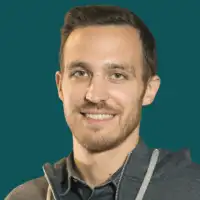
I'm the Founder and Editor-In-Chief of B2B SaaS Reviews and the Director of Demand Generation at PartnerStack, the leading platform for partner management and affiliate marketing in B2B SaaS. My experience spans several notable B2B SaaS companies, including Influitive (Advocate Marketing), LevelJump (Sales Enablement, acquired by Salesforce), and Eloqua (Marketing Automation, acquired by Oracle). I hold a Bachelor of Commerce in Marketing Management from Toronto Metropolitan University and a Master of International Business from Queen's University, with academic exchanges at Copenhagen Business School and Bocconi University.

